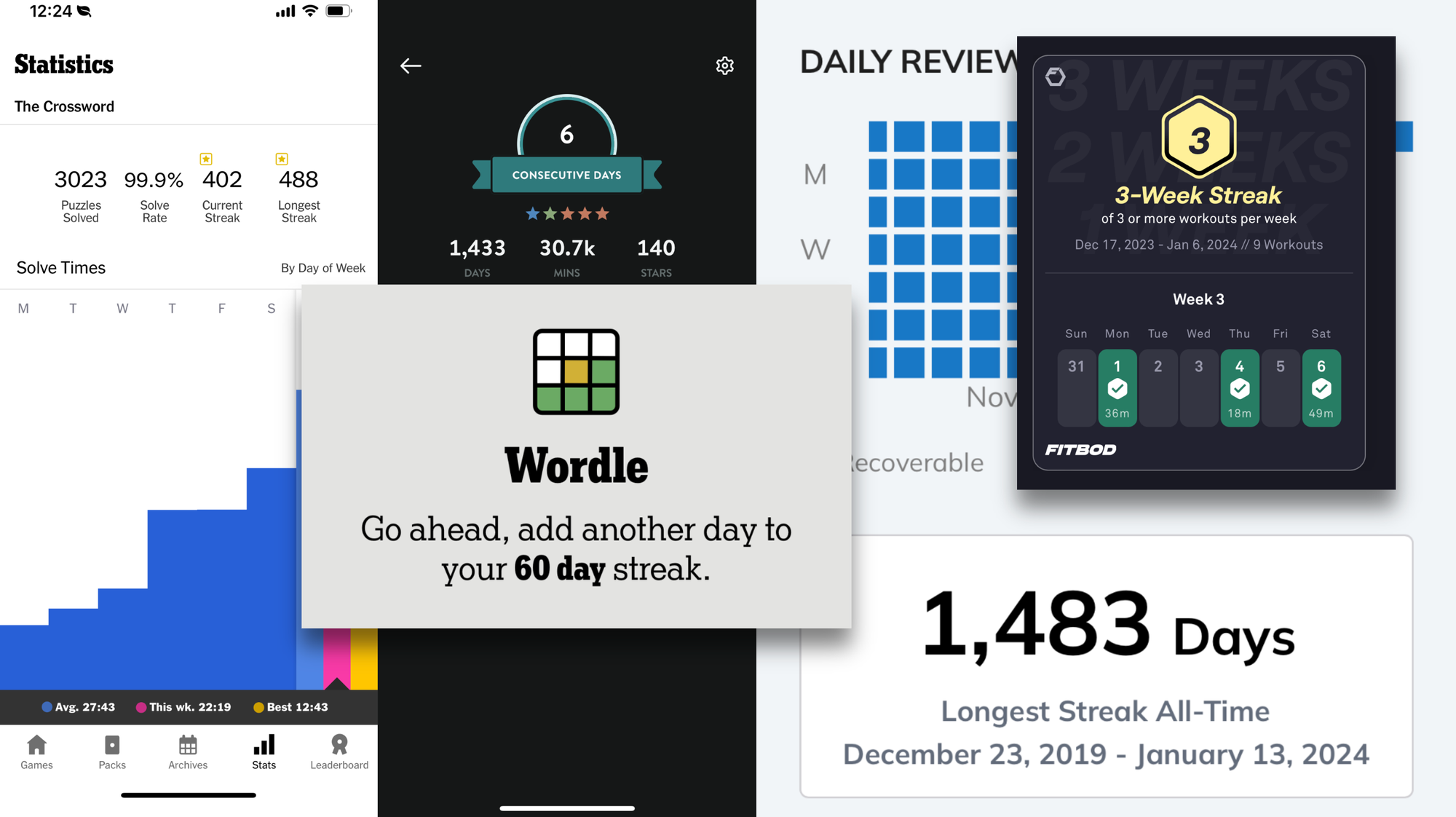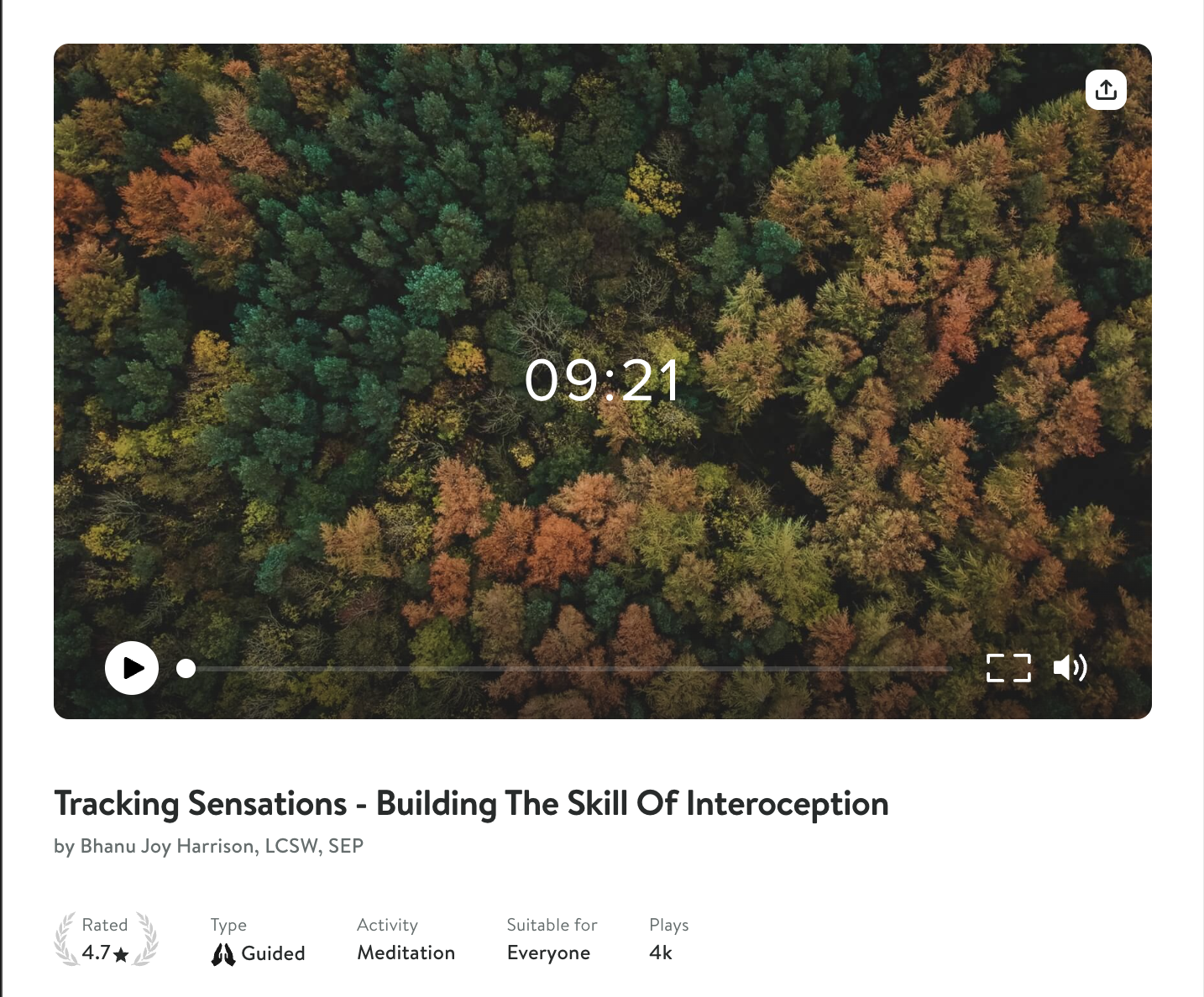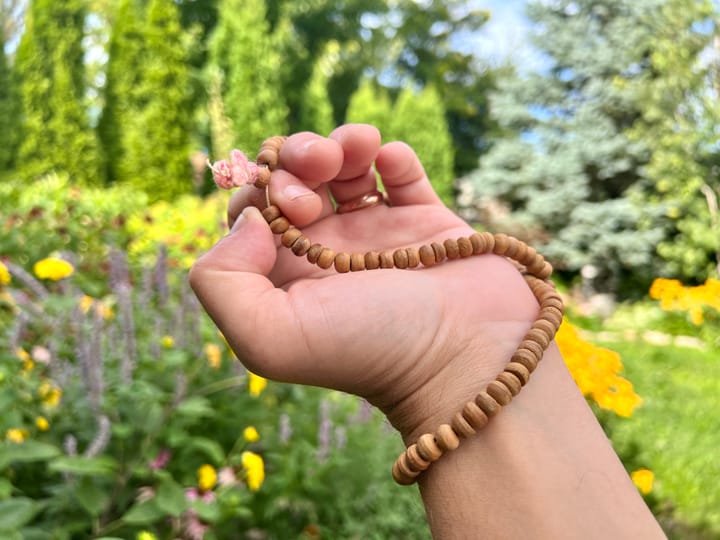Last week I broke a long streak of daily meditation, a small bummer that got me thinking about how and why we track our own evolution over time. This week’s theme is streaks: how they work, how to choose them, and how to diversify your timescales to understand how you are growing in more ways.
Hello again, and welcome to the frigid third week of so-called 2024! I told you I’d write less this week, and I really meant to, but instead I wrote even more. Sorry! You can skip to the plural practices to try (there are six!) if you’re in a hurry.
🦡💔 The tiny melancholy of the broken chain
This past Monday, I opened my meditation app to discover a bleak gray 0 overlaid on my name. I’d been so absorbed in writing to you the day before that I’d gone and broken a months-long meditation streak.
Several of the voices in my head uttered simultaneous exclamations of despair at this awful news, ranging in style from the Professor’s elaborate profanity to the little Badger’s tremulous “Oh, bother!”
“Whoops,” I chuckled lightly. “Oh well, no big deal.”
“Well not to you, perhaps,” the Badger hotly replied. He collapsed to the floor in a despairing heap, lower lip a-tremble. “But to some of us — ! Oh, now we’ve lost everything, and we’ll have to start all over again, from the very beginning. As though we’d never meditated at all!”
The Professor scooped the Badger up and cuddled him before he could start crying in earnest. “I know how you feel, little one,” he murmured, gently patting his back. He looked at me sadly. “It doesn’t actually matter, of course. And it’s not very meditative to be upset about it. But still, what a stupid waste.”
I have been meditating more or less every day for eight years now; meditation is very much a part of daily life in my inner world, and nothing about that had changed. Nothing at all has been wasted or lost; nothing has even changed. But for Badger and the Professor — honestly, for the majority of who I am, my body included — the tiny zero in the meditation app felt like the loss of something wonderful, something we had worked hard to bring into being and sustain in life.
All this sadness over an app! A make-believe ending, a tiny death — but it felt all the more mournful because it was too trivial to be mourned at all.
“I’m sorry I made light of it, you guys,” I said. “I know these things are very important to some of us.”
The Badger nodded solemnly against the Professor’s shoulder. “They are very important, period,” he sniffled.
Sometimes it really does feel that way, like right now. Two weeks into the new Gregorian year, you can practically hear the melancholy tinkle of streaks breaking all over the world.
🗓️🪥 The awesome power of the streak

A streak, as I am thinking about it, is an unbroken run of consistency. Some of them are quite out of our control, like winning streaks; they last only as long as they last, which is why they are so suspenseful to follow. But I am thinking here about the streak people start and sustain on purpose — often to coincide with the “fresh start moments” that I wrote to you about last week.
- Streaks of commitment to commonly aspired-to practices or states of being often become highly transmissible as memes: Whole 30, 75hard, Dry January, NaNoWriMo, Movember.
- If a particular public streak is popular enough for long enough, it can crystallize into the durable material of culture itself, like Ramadan or Lent.
- Other streaks are purely individual but openly talked of, like a public commitment to quit smoking or booze, or an Insta-documented daily streak of workouts, lewks, extreme water-drinking, etc.
- Then there are all our many private internal streaks people never talk about to another living soul: the white-knuckled resisting-my-shameful-secret-addiction streak, the not-taking-my-own-life-today streak, the daily-rosary-so-God-will-forgive-me streak.
Streaks are powerful because they let us change our behavior, often durably, in ways that parts of us really do not want to. You only enter into a streak when you need to overcome some real internal controversy. When I started meditating in earnest some years ago, many parts of me were frankly terrified to sit in silence for more than a few seconds at a time. It was only the coercion of an app-monitored streak of days that made it bearable at the start.
🪥 How I learned to brush my teeth
No part of me objects to daily toothbrushing, by contrast, so there is no need to visualize an unbroken chain of brushings. But toothbrushing is only uncontroversial among my “internal family” today because, if decades-old memory serves, my mother had me track every time I brushed my teeth for three straight weeks.
Though she didn’t call them “streaks,” my mother knew what they were and made much use of them. She believed that 21 days of daily practice could make any practice a habit, which is true if you think it is, and she showed me how to track my progress toward toothbrushing — and many other forms of good behavior, like non-thumbsucking or sleeping alone all night — on the monthly At-a-Glance calendar in our kitchen.
No part of small Ash ever wanted to cultivate such habits, of course. But the overwhelming consensus of voices in my little head wanted nothing more than to please my mother, so I bravely made my Xs on the calendar.
I always earned some kind of reward when I succeeded, as I recall, but I can’t remember any of them. The real prize was always the streak itself: a material realization of 21 virtues in three neat rows, pure and perfect and unchanging. The messy diversity of my unpredictable childhood behavior, disciplined into order and beauty!
Once Xs start joining arms across the boxes of the days, their orderly continuity starts to seem as beautiful as a perfect six-pointed snowflake or a bubble iridescent in the sun, self-evidently precious. A streak turns an internally controversial practice into a frail and beautiful treasure, worth protecting at all costs. And when it breaks, the loss of it can feel, to certain parts of us, like the death of an innocent from sheer negligence.
Because of their immense emotional power, streaks of consistent behavior can be encouraging, empowering, even lifesaving. As my mother knew, a well-timed streak can turn a loathed chore into a virtually effortless habit that lasts your whole life long. But even the best-intentioned streaks can drown out important inner warnings, spiral into anguished obsession, and drive up the emotional cost of failure so high that you can’t afford to try.
That’s why it is a good idea to choose your streaks very carefully, and to keep a compassionate eye on them to make sure they are making things better for all of who you are, on the whole, rather than worse. Here are no fewer than six (6) ideas about how you might do just that.
Plural practices for tracking your evolution
1. 🌞 Try “one day at a time”
Streaks are so unpredictable that you really shouldn’t bet your life on one. When doing things differently really counts, try doing the new thing one day at a time. That’s how I once stayed sober for more than four thousand days in a row; which, what! Yet it happened.
I learned about this practice at my very first A.A. meeting, where I was told explicitly that the best I could hope for was “a daily reprieve” from the misery of alcoholism. Even that cold comfort was better than none at all, so I “kept coming back,” day after day, for more than a decade of days.
The beautiful ceremony of sobriety medallions invariably comes with a warning: the only meaningful unit of sobriety is the solar day. An old-timer, rising creakily to her feet to receive a medallion for thirty-something years from their even older sponsor, will seldom fail to say that they could very well start drinking again tomorrow, and resolve to “keep coming back” one day at a time.
So: if there’s a goal that’s really important to you, track one day at a time. Every morning, when you wake up, resolve to keep it at it just for today.
2. 💬 Let the people speak
Streaks are so powerful and so dangerous because they turn a diversity of opinions about what you might do into the appearance of tidy sameness, which can hide all manner of internal dissent. Deliberate attempts to sustain new behaviors always fail when they encounter sufficient opposition from within. One of the most viral meme-streaks circulating at present is a cartoonishly on-the-nose provocation to inner discord, which its inventor describes as a “Tactical Guide to Winning the War with Yourself.”
Whether you are midway through a streak or contemplating starting one, it’s never a bad idea to take stock of all the ways you feel about it.
This simple practice can strengthen your commitment to a widely shared internal goal, uncover the concerns that underlie “resistance,” or suggest a change of course. No matter how the conversation goes, the choice you make at the end of it will be easier to sustain over time because it has democratic legitimacy.
Here are two ways to go about it:
2A. 🗳️ Deliberative democracy
If you have good relationships with various parts of yourself, invite them to join you for a meeting to discuss the streak. Everyone should have the chance to weigh in without interruption, in whatever form they find most expressive. Once everyone has had a say, call a vote.
You can make your own rules for your inner democracy — you might require total consensus, or a two-thirds majority, or whatever other form of agreement feels fair and legitimate to everybody inside.
This is how my inner community decided, after months of deliberation, that it was time for our eleven-year streak of sobriety to come to a gentle end.
2B. 📞 Opinion polling
Even if you don’t experience various parts of your personality in an individualized sort of way, you can still gauge the level of inner support for a planned or current streak: Challenge yourself to list as many sincere opinions about it as possible, no matter how silly they might seem to you.
This practice offsets the persuasive power your most reasonable-sounding or culturally prestigious motivations by asking for sincerity rather than practicality. Lowering the bar for participation in debate can lead to remarkable results. A recent poll about my three-days-a-week workout streak, for example, revealed a startling groundswell of popular opposition to the practice. I did not do my exercises today, and I’m not sorry either. The people have spoken.
3. 💧🐇 Try a different year
Gregorian years are convenient and intuitive ways to build habits or track progress because other people agree about what 2024 means. It’s socially meaningful stick to something consistently for a whole year, even if you never tell anybody about it. If you did, they’d be impressed.
But you can track your evolution at the annual scale in all sorts of different humanly meaningful ways. The internet tells me today is not only January 14, 2024, but also
- the fourth of Shevat in the Jewish year 5784, and
- December 5, 2023, in the Chinese year of the water rabbit.
If there is a non-Gregorian way of measuring years that you find personally meaningful, you can try using that to understand your progress in a way that’s helpfully offset from ordinary workaday time. If you adopt a calendar you haven’t inherited in some way, you might want to consult folks who did inherit it about how to work with it respectfully.
4. 🌜Measure time with your senses
Nobody feels the Gregorian calendar, but most people can look up at the moon as it changes night by night, and many of us can also perceive their own monthly cycles directly. Measuring time according to these categories can be a helpful alternative.
4A. 🌚 Track things by the moon
My friend Sarah has a practice of starting new projects when the moon is full, and planning time for quiet and reflection for the new moon. Those dates that slide dramatically hither and thither across Gregorian months, which has the fascinating effect of decoupling her schedule from other people’s cycles of monthly and yearly urgency. If the moon makes sense to you, give lunar scheduling a try.
4B. 🩸 Measure time by your own cycle.
When I told my colleagues at the Sweet Water Alliance about Sarah’s lunar-scheduling thing, they schooled me about what menstrual time — a vivid lived reality for half of all human beings, about which I, a 44-year-old queer man with a graduate degree and therapeutic training, knew literally nothing.
Many Alliance folks are birth workers, and most of them have wombs or used to, so they are exceptionally skilled at sensing time and measuring progress one human menstrual cycle at a time. If you have a more-or-less monthly cycle of your own, you can use it as the unit of a streak, a scheduling template, or a social calendar.
Doing this, they tell me, can help you come to a more compassionate awareness of the diversity of your own experience — and, sometimes, tap into undiscovered inner sources of inner wisdom and power.
5. ⛰️ Zoom out to larger timescales
I like to press the proverbial Google Earth button from time to time to instantly change my perspective when shit done got too heavy. — Mama Ru
Your life looks quite different when you zoom out, often in interesting ways — the way the town where you live looks eerily different when you look down on it from an airplane. For new perspectives on your own evolution, try tracking it on larger timescales. For example, try:
- By decade. Things look different when you look back on your life over decades rather than single years. This graph of where I’ve lived over time has helped me come to more inner comfort with the idea that my husband and I — who are getting queerer and older by the day — might decide to leave the United States at some point.
- In geologic time. When you really need to recalibrate your sense of who you are and what matters, try conceptualizing your behavior or progress on the timescale of the planet. Interactive visualizations like this one can help.
5. 🦠 Zoom in to smaller timescales
Okay, just one last practice for this week: sometimes, the best scale to measure your evolution is moment by moment. When the pressure to change starts feeling overwhelming, try zooming in to the smallest unit of time you can by tuning in to your moment-by-moment experience.
This doesn’t come naturally to me at all, and I seem able to do it best when I am very relaxed or very anxious. This simple ten-minute meditation by Bhanu Joy Harrison has helped me achieve wonderful “streaks” of deliberate interoception that last for seconds or even minutes at a time:

That’s all for me today, friends! If you’ve been tickled, vexed, inspired or amused by this newsletter in any way, just hit reply and let me know.
Also, if you have any ideas about how to write shorter newsletters, please send them my way. My system will be grateful.
Your plural pal,
Ash




